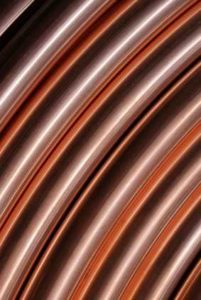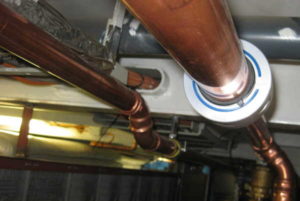Copper Copper pipes are often used in newer properties. Until some time ago, copper pipes were considered the ultimate ratio among water pipe materials. This metal pipes need with good water, no repair and no plumbing. In the meantime, multilayer composite pipes (metal / plastic) or the cheaper variation normal plastic pipes have been installed.
Ideally, a thin, smooth film of limescale forms inside the pipe along the wall and protects the copper from corrosion. Unfortunately, if the amount of calcium carbonate in the water is too high, this is not possible and copper pipes can clog just as any other pipe.

Corrosion of Copper – Preconditions
Copper pipes can be an ideal solution if the water’s properties (hardness, pH-value, water flow, quality) work well with the material itself. We’ll have a look at some factors which can lead to copper corrosion and even pitting in the pipe.
Water hardness
When in contact with soft water, with only little limescale, corrosion can be an issue in copper pipes. The „protective layer“ made of calcium carbonate is too thin and the copper is in direct contact with the water, which is a necessary precondition to enable corrosion processes.
pH Value
Also the pH value is a critical factor which can lead to corrosion in copper pipes. In cases of rather high or low pH values the risk of corroison increases.
Stagnant Water
A constant flow of water reduces the risk of corrosion. Where water is stagnant and remains still, the oxygen is released by outgassing and reacts with the copper. Copper oxide is formed which can be seen as greenish color of the water, if the process is advanced. Also visible limescale deposits in the system can get a blue-green shimmer, which is typical of copper.
Foreign Metal particles
Metal impurities in the water can lead to contact corrosion. This happens, for example, when rust particles from the public water network enters the piping system. Iron particles and copper can form a galvanic element leading to (pitting) corrosion. In these cases we only have minor influence on the corrosion through the Merus Technology. The galvanic element and this kind of corrosion is usually too strong to be affected by the Merus Oscillations. Here we observe so calles pinholes leaking througout the whole system which need repair work by a plumber.
Results: Prevention with the Merus Technology

Our Merus Ring is installed – as usual – at the main water inlet. It has several tasks to achieve the overall goal of less corrosion:
- Decomposing existing limescale incrustations.
- Keeping the oxygen solved and therefore reduce corrosion in stagnant water.
- Reducing corrosion due to soft water by changing the general conditions for chemical processes.
After the installation the effect is visible when observing greenish color and limescale incrustations for example in kitchen and bathroom. Thus the color of the water and incrustations can be an indicator for the corrosion in the pipes. This also prevents the pipe from forming pinhole leaks.
Sometimes we recommend to use a particle filter at the main water inlet to make sure no metal particles enter the system. Compared to the costs for new pipes, the costs for a filter are rather low.
Discussing results
What we explain concerning solving limescale and preventing corrosion is a complex topic summarized in short. Therefore the different effects appear to be mutually exclusive. But in fact, the conditions in the pipe are changed by the Merus Technology to interfere with certain chemical processes and form a thin protective layer along the walls itself. Therefore we are quite successful in reducing copper corrosion.
Short digression: Copper in heat exchangers
Copper is also often used in heat exchangers because of its very good thermal conductivity. In particular, smaller, so-called brazed plate heat exchangers are often made entirely of copper. Such small heat exchangers are also frequently found in district heating systems.
If such heat exchangers are filled with water, Merus is also able to dissolve existing limescale incrustations. There are results and figures under „Volume in heat exchanger„.
